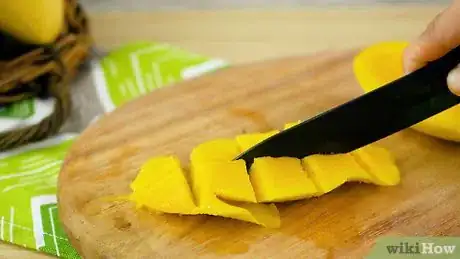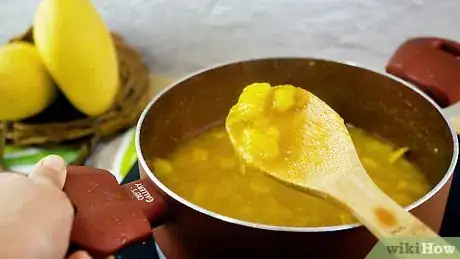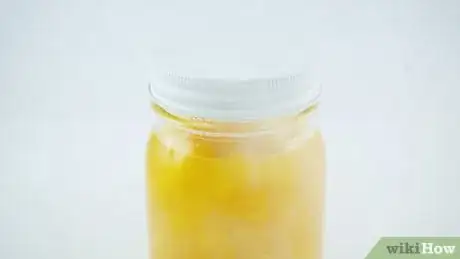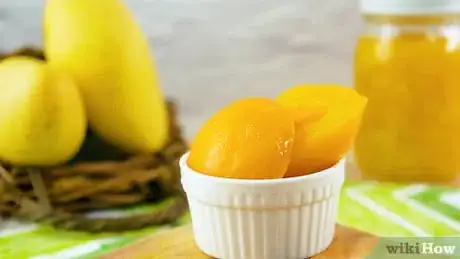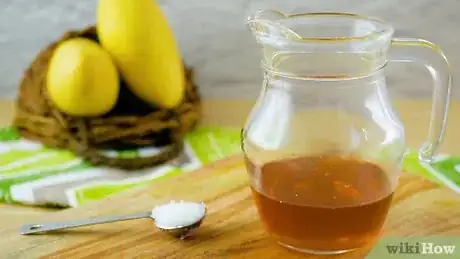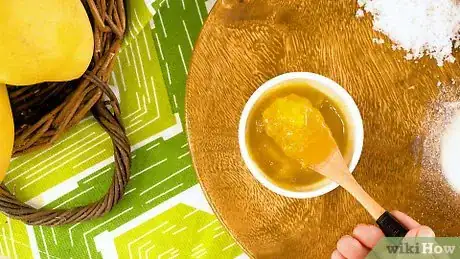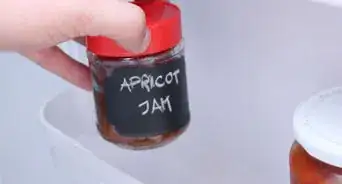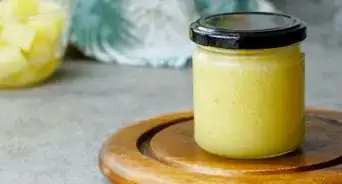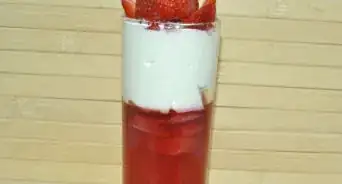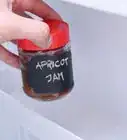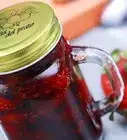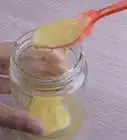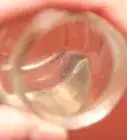This article was co-authored by wikiHow staff writer, Jessica Gibson. Jessica Gibson is a Writer and Editor who's been with wikiHow since 2014. After completing a year of art studies at the Emily Carr University in Vancouver, she graduated from Columbia College with a BA in History. Jessica also completed an MA in History from The University of Oregon in 2013.
There are 9 references cited in this article, which can be found at the bottom of the page.
The wikiHow Video Team also followed the article's instructions and verified that they work.
This article has been viewed 233,484 times.
Learn more...
Making jam is a great way to capture the natural sweetness and delicate flavor of mangoes. Chop the mangoes into small pieces and cook them with lots of sugar, lemon juice, and pectin. You can even customize your mango jam to come up with completely unique flavor combinations. Once the jam is as thick as you like, transfer it to sterilized jars and enjoy the jam on toast, waffles, or pancakes.
Ingredients
- 6 to 7 large mangoes
- 1 cup (200 g) of sugar
- 4 tablespoons (59 ml) of lemon juice
- 2 tablespoons (25 g) of powdered pectin
Makes 2 cups (650 g) of jam
Steps
Cooking Basic Mango Jam
-
1Slice the flesh from 6 or 7 large mangoes. Rinse the mangoes and put them on a cutting board. Hold a mango against the board and carefully cut down 1 side of it. Try to cut as close to the seed in the center, so you're able to remove the most fruit. Then, slice down the other side of the mango. Scoop the flesh from both pieces and chop it into 1⁄2 inch (1.3 cm) pieces.[1]
- Use a small knife to trim the flesh around the seed itself.
- You should get around 4 cups (660 g) of mango pieces.
-
2Put the mango pieces in a pot with sugar, lemon juice, and pectin. Place the chopped mango in a large pot on the stove. Add 1 cup (200 g) of sugar, 4 tablespoons (59 ml) of lemon juice, and 2 tablespoons (25 g) of powdered pectin.[2]
- The pectin helps the jam set up. If you prefer a looser jam, you can leave the pectin out.
Advertisement -
3Stir the mixture and cook it over low heat until the sugar dissolves. Stir well so the mango pieces are coated with the sugar. Continue to stir the mixture every few minutes until the sugar dissolves and becomes liquidy.[3]
- It should take about 3 to 4 minutes for the sugar to dissolve.
-
4Bring the jam to a boil over medium-high heat. Turn the burner up so the liquid becomes syrupy and starts to bubble vigorously. Stir the jam occasionally to prevent it from sticking to the pot or boiling over.[4]
- It's important to use a large pot so the jam doesn't bubble over as it cooks.
-
5Cook the mango jam until it reaches 220 °F (104 °C). Clip a candy thermometer to the side of the pot or occasionally insert an instant-read thermometer into the jam to see if the jam has reached the setting temperature of 220 °F (104 °C). Stir the jam occasionally as it bubbles and thickens.[5]
- Skim off foam that floats to the top of the jam and discard it since becomes rubbery if you leave it in the jam.
Tip: If you don't have a thermometer, place a small plate in the freezer when you begin to make the jam. To test if the jam has set, spoon a coin-sized amount onto the chilled plate and push your finger into it. The jam should wrinkle and hold its shape.
-
6Spoon the jam into sterilized jars. Get out 2 sterilized half-pint jars and place a funnel on a jar. Carefully spoon the mango jam into the jar and leave 1⁄4 inch (0.64 cm) headspace. Place a sterilized lid on the jar and screw on a band until it's finger tight.[6]
- Although you can soften the lids in hot water before pressing them on the jars, you don't have to in order to get a good seal.
-
7Process the jars or store them in the refrigerator. For long-term storage, place the jars in a water bath so they're covered by at least 1 inch (2.5 cm) of water. Boil the jars for 10 minutes and then set the jars aside until the jars are at room temperature. If you don't want to can the jam, put the jars in the refrigerator and use them within 3 weeks.[7]
- If you process the jam, store the jars at room temperature for up to 1 year. Press down on the lid to check that the seal doesn't pop back up before you open the jar and eat the jam.
Trying Variations
-
1Swap half of the mango for peaches or nectarines. Although pure mango jam is delicious, it's also fun to add another fruit to the jam. Use half of the mango called for in the recipe and replace the other half with peeled peaches, nectarines, or stone fruit. Mango also pairs well with any of these fruits:[8]
- Strawberries
- Papaya
- Pineapple
- Raspberries
- Plums
-
2Substitute honey or alternative sweetener for the granulated sugar. If you don't want to use white sugar, add as much of your favorite sweetener as you like. Try honey, agave, or a low-calorie sweetener. Keep in mind that since sugar acts as a preservative and you're leaving it out, you'll need to refrigerate the mango jam and use it sooner.[9]
- Store jars of the mango jam in the fridge for up to 3 weeks.
-
3Add 1 teaspoon (2 g) of your favorite ground spice for a unique flavor. Customize your mango jam by stirring in dried spice halfway through the cooking time. You can use a single spice or a combination that equals 1 teaspoon (2 g). Consider using any of these spices or seasonings:[10]
- Cardamom
- Cinnamon
- Ginger
- Nutmeg
- Vanilla paste
Tip: You can also add a pinch of red pepper flakes for a slightly spicy jam or include a few strands of saffron to give the jam a rosy color.
-
4Leave out the sugar and pectin to make a loose mango spread. If you want the natural sweetness of the mango to really come out, don't add any sugar, honey, or sweetener. Cook the mango with 1⁄2 cup (120 ml) of water over medium heat until the mango breaks down and thickens.[11]
- If you'd like smoother spread, push the mango spread through a fine-mesh strainer set over a bowl.
- Because there's no added sweetener to the spread, store it in the refrigerator and use it within 2 weeks.
Community Q&A
-
QuestionI have mango pulp. Can you tell me how to cook mango jam?
 Community AnswerYou have to pour the pulp into a saucepan, then add a teaspoon of pectin and 3 cups of sugar. Then add a little bit of butter and a pinch of salt. Leave it to simmer for 5-8 minutes.
Community AnswerYou have to pour the pulp into a saucepan, then add a teaspoon of pectin and 3 cups of sugar. Then add a little bit of butter and a pinch of salt. Leave it to simmer for 5-8 minutes. -
QuestionWhen making the mango jam (apple-flavored), must I mash the mango to jam-like consistency?
 Community AnswerYes, to make it smooth. If you want it chunk,y don't mash too much.
Community AnswerYes, to make it smooth. If you want it chunk,y don't mash too much. -
QuestionHow do I make mango jam without pectin, lemon juice and lemon zest?
 Community AnswerSounds like you might just puree up some mangoes with a little sugar. I would recommend making it only in small batches, because the lemon juice is what keeps it from browning. Keep it in the fridge and use immediately.
Community AnswerSounds like you might just puree up some mangoes with a little sugar. I would recommend making it only in small batches, because the lemon juice is what keeps it from browning. Keep it in the fridge and use immediately.
Things You'll Need
- Measuring cups and spoons
- Knife and cutting board
- Large pot
- Spoon
- Small plate
- Candy thermometer or instant-read thermometer
- Funnel
- Jars with lids
References
- ↑ https://www.thekitchn.com/how-to-cut-a-mango-cooking-lessons-from-the-kitchn-166290
- ↑ https://www.kawalingpinoy.com/mango-jam/
- ↑ https://www.kawalingpinoy.com/mango-jam/
- ↑ https://www.washingtonpost.com/recipes/mango-jam/14639/
- ↑ https://www.washingtonpost.com/recipes/mango-jam/14639/
- ↑ https://practicalselfreliance.com/mango-jam/
- ↑ https://nchfp.uga.edu/how/can_07/storing_jams.html
- ↑ https://www.food.com/recipe/papaya-and-mango-jam-12688
- ↑ http://www.scratchingcanvas.com/healthy-spicy-mango-jam-no-sugar-no/
About This Article
If you want to make mango jam, start by removing the skin and cutting a ripe mango into thirds. Cook the mango in a pan with 2 cups of sugar for 25-40 minutes until the mixture is thick. Then, use a fork to mix and mash the mango until it has a jam-like consistency. In a separate bowl, mix hot water and ascorbic acid together, and then pour the mixture into the jam to act as a preservative. Can the mixture in a jar and store it in the refrigerator to keep it fresh. For tips on how to make a low-sugar or apple flavored mango jam, read on!
